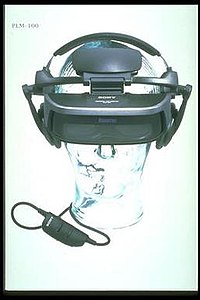Stereoscopic video game
 |
| Part of a series on |
| Video game graphics |
|---|
| Art and video games |
|---|
|
|

A stereoscopic video game (also S-3D video game) is a
Description
Stereoscopic video games have been available for several years for PCs through the
Although no longer considered a key feature for successful game development by as many as during the stereoscopic 3D hype in 2010, stereoscopic support for video games is still considered a minor enhancement to video games. Many individuals consider it to be the most significant enhancement to video games.[3] One of the reasons for the technology's lack of success was that the surprise effect quickly wears off.[4]

A study at the University of Derby showed that converted 2D games do not transfer very well to stereoscopic 3D and concluded: "... games targeted to stereoscopic 3D audiences and devices must be designed from the start with stereoscopic 3D in mind." Therefore, stereo video games must have elements that can only be achieved in S-3D for a proper stereoscopic immersion.[5]
For example, in the game
Developers also need to mind perceptual problems such as
Recent developments of consumer
Rendering techniques
There are two primary rendering techniques employed in stereoscopic video games: 2D + depth rendering, and dual rendered 3D.[9]
2D + depth rendering
This technique generates a second point of view from a single rendered image. It has an upper limit on how much parallax can be created. 2D+ can be compared to 2D to 3D conversion techniques for 3D films. Several video games for Xbox 360 and PS3 used this method.[9]
Dual rendering
This technique renders two images. It creates the best stereoscopic effect but has double system requirements for graphic rendering and higher production demands.[9]
History
This section needs additional citations for verification. (May 2014) |
1980s

Sega released the world's first commercial stereoscopic video game, SubRoc-3D, in 1982.[10] This arcade game introduced an active shutter 3D system, jointly developed by Sega with Matsushita (now Panasonic).[11] In 1983, the first model of the TomyTronic series of gaming laptop LCD game & watch-type stereoscopic 3D was released by Takara Tomy.[12] A 3D imager for the console Vectrex vector, a pair of 3D glasses using a rotating color wheel synchronized with the display was released by Smith Engineering in 1984.
Battle Bird, developed by
In 1987, the shutter-based
1990s
In 1991, the
In early 1997, Sega demonstrated an early glasses-free 3D display system, called the Floating Image System. It displayed 3D imaging based on a multi-layer parallax system, and was presented by Sega AM3's general manager Hisao Oguchi.[23]
Metabyte produced Wicked Vision the first driver that made a half-resolution stereo (sync doubling) of more than fifty gaming PC (Glide, Direct3D and miniOpenGL)
2000s

The GameCube (and Game Boy Advance to a lesser extent) had been built with Stereoscopic capabilities in mind, however the cost for the liquid crystals technology were prohibitively expensive at the time to make commercial sense.[24][25][26]
In 2001, NVIDIA brought out a driver based on Elsa technology that supported different types of glasses and screens, but only with their own graphics cards. The PUD-J5A for the PlayStation 2 was released in 2002, which incorporated virtual helmet technology (Glasstron) and was sold exclusively on the internet in Japan. It weighed 320 grams (11 oz), and used two screens of 108,000 pixels each (probably 450x240 pixels)[27] and had a single game (Energy Airforce Aim Strike![28]).
In 2005, the game Metal Gear Acid 2 was released on the PlayStation Portable from Sony with a stereoscopic rendering via the "Solid Eye" accessory that included a stereoscope lens cardboard that could never be reused. The EyeFX 3D shutter glasses for the PlayStation 2 was produced by SplitFish Gameware in 2006. This plugged into a joystick port of the console and added support for stereoscopic 3D in ten existing games. The 3D Vision kit for the latest generation of NVIDIA graphics cards was brought out in 2001, and combines a pair of LC shutter glasses as well as a wireless infrared transmitter connected to a USB driver for Windows.
2010s
In 2010, stereoscopic support for the PlayStation 3 was released via an automatic update of firmware. The new software includes a function for detection of 3D displays and a stereoscopic frame-buffer support.
In October 2010 Josef Kunz published the app 'Difficult' in the apple appstore, a skill game, that uses a
The
See also
- List of stereoscopic video games
- List of Nvidia 3D Vision Ready games
- List of Nintendo 3DS games
- List of PlayStation 3 games with 3D support
- List of Wii U games
- List of Xbox 360 games with 3D support
- 3D film
References
- ^ "MTBS GameGrade 3D". Gamegrade3d.com. Retrieved 2014-05-24.
- ^ "Best and worst stereoscopic 3D console games (photos)". CNET. 2011-12-14. Retrieved 2014-05-24.
- ^ a b c d Leadbetter, Richard (23 June 2012). "What Went Wrong with Stereo 3D?". Eurogamer.
- ^ Orland, Kyle (2012-07-15). "What happened to the stereoscopic gaming revolution?". Ars Technica. Retrieved 2014-05-24.
- S2CID 15290066.
- S2CID 62657173.
- ISBN 978-3-642-24499-5.
- S2CID 1091895.
- ^ a b c "A Developer's Guide To Stereoscopic 3D In Games". Gamasutra. 2011-08-17. Retrieved 2014-06-14.
- ^ Edwards, Benj (2011-03-03). "The History of Stereoscopic 3D Gaming". PCWorld. p. 3. Retrieved 2014-05-24.
- ^ "The Arcade Flyer Archive - Video Game Flyers: Subroc-3D, Sega".
- ^ "The top ten retro gaming secrets".
- ^ "バトルバード" [Battle Bird]. Media Arts Database (in Japanese). Agency for Cultural Affairs. Retrieved 11 May 2021.
- ^ Computer Gamer. No. 12. pp. 26–7.
- ^ ISBN 4-946432-31-0.
- ^ "Overseas Readers Column" (PDF). Game Machine (in Japanese). No. 301. Amusement Press, Inc. 1 February 1987. p. 22.
- Allgame. Archived from the originalon November 14, 2014. Retrieved March 31, 2014.
- ^ Plunkett, Luke. Nintendo's First 3D Technology Shot A Spaceship At Mario's Face. Kotaku. 30 April 2010.
- ^ "Continental Circus arcade game review".
- ^ Horowitz, Ken (December 28, 2004). "Sega VR: Great Idea or Wishful Thinking?". Sega-16. Archived from the original on 2010-01-14. Retrieved 21 August 2010.
- ^ "SegaVR". YouTube. Retrieved 30 December 2013.
- ^ "Quick Hits". GamePro. No. 89. IDG. February 1996. p. 17.
- ^ Electronic Gaming Monthly, issue 93 (April 1997), page 22
- ^ Serrels, Mark (2011-01-07). "The Gamecube and the Game Boy Advance Were 3D Compatible!".
- ^ "Iwata Asks".
- ^ Beta64 (11 December 2012). "Beta64 - Luigi's Mansion" – via YouTube.
{{cite web}}: CS1 maint: numeric names: authors list (link) - ^ "Sony prepares sales of PUD-J5A head-mounted display". iXBT Labs. Retrieved 2014-05-25.
- ^ "'Energy Airforce: Aim Strike!' (PS2) - Screens & Trailer". Worthplaying. 2005-02-10. Retrieved 2014-05-25.
- ^ "100 Stereoscopic 3D PS3 Games Available". 3D Tested. 2012-05-28. Retrieved 2014-05-25.
- ^ "3D PS3 Games List". 3D Tested. Retrieved 2014-05-25.
- ^ "New 3DS XL Review". GameSpot. Retrieved 2023-05-08.
External links
- The History of Stereoscopic 3D Gaming PCWorld
- Stereoscopic 3D video games and their effects on engagement Presentation on YouTube
- What happened to the stereoscopic gaming revolution? Article on arstechnica
